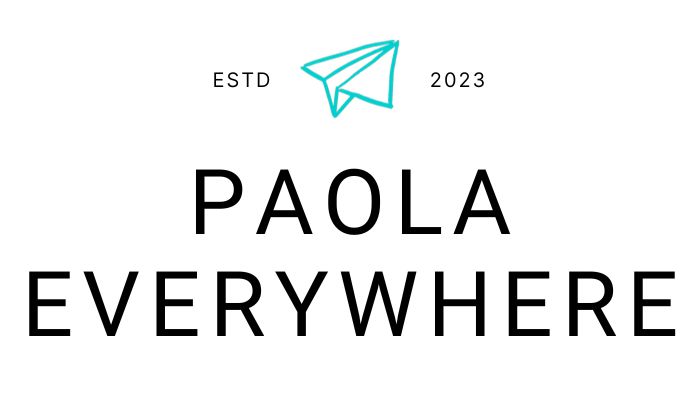Embarking on a car journey through Hungary is a gateway to a unique and authentic side of the country, far from the usual tourist spots. As you bid farewell to Budapest, a world of picturesque villages, quirky museums, and traditions that you can only experience by driving through the countryside and lesser-known towns unfolds. With a spirit of adventure and a few Hungarian phrases, my son and I set out to uncover Hungary’s hidden gems. Our road trip led us through paprika fields, thermal baths, natural landscapes, and age-old traditions, an itinerary you can follow step by step in this article.
Table of Contents
Road Trip in Hungary: Discover Paprika, Museums, and Authentic Traditions
A road trip in Hungary is the ideal way to uncover the authentic soul of this fascinating country. Travelling by car allows you to explore small villages, rural landscapes and lesser-known attractions, reaching places untouched by mass tourism.
PLAN YOUR TRIP TO HUNGARY
For a road trip in Hungary, choose a Holafly eSIM: you will have unlimited internet to use Google Maps or any other GPS app, and you can share photos and videos in real time on WhatsApp and social media without any worries.
To travel with complete peace of mind, don’t forget to also take out Heymondo travel insurance, which protects you from unexpected events and ensures a worry-free holiday.
We drove from Italy, but you can easily rent a car directly at Budapest Airport. I recommend checking DiscoverCars to find the best deals. Road conditions range from comfortable motorways to unpaved country lanes. Yet, overall, I found the traffic to be smooth and the roads to be well-maintained.
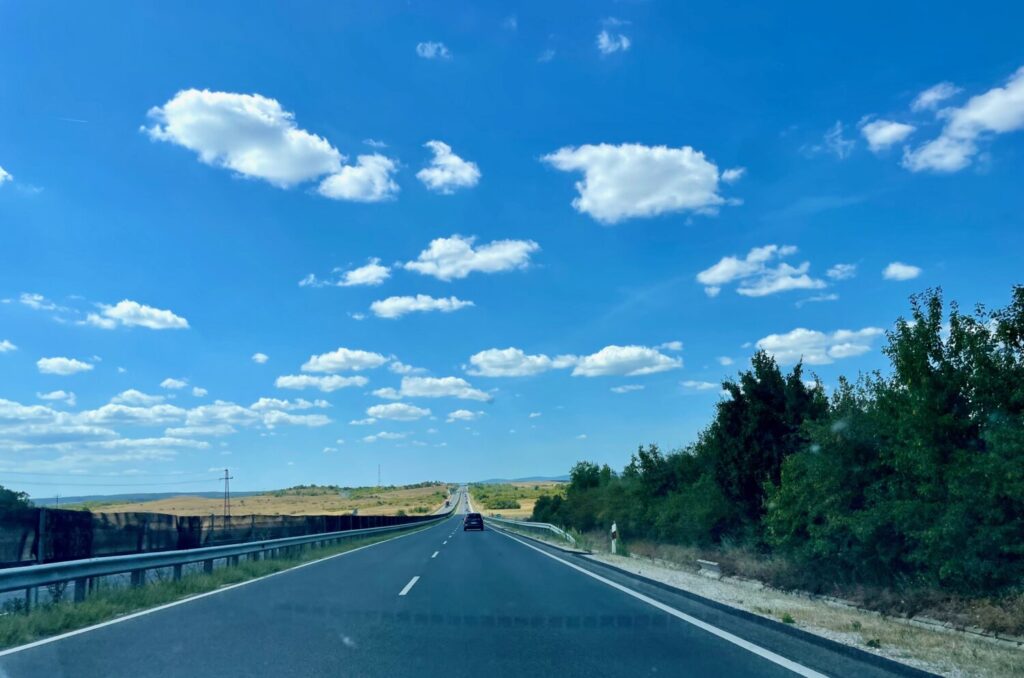
What to See in Hungary Beyond Budapest
One of the elements that best defines Hungary is paprika, the country’s iconic spice, which tells stories of farming, trade and deep-rooted culinary traditions. Kalocsa is undoubtedly the place to visit if you want to discover it. More akin to a provincial town than a city, it boasts a dedicated museum as well as historic factories.
Alongside its culinary traditions, our trip included unusual and engaging museums. In Szolnok, we visited RepTár, the aviation museum, an unmissable stop for aviation enthusiasts like us. This museum, one of the largest and best organised in Europe, gave my son the chance to enjoy historic aircraft and flying simulators.
In Mezőkövesd and Szentendre, we immersed ourselves in the local folk art and traditions. At the Matyó Museum, we admired the vivid colours and embroidery typical of the Matyó community. At the Skanzen open-air ethnographic village, we explored traditional architecture from different regions of Hungary, from thatched cottages to Art Deco buildings.
No road trip in Hungary is complete without discovering its natural wonders, such as Lake Hévíz, the thermal lake, and the Tapolca Lake Cave. Camping on Lake Balaton, the “Hungarian sea”, was the perfect finale to our adventure. It allowed us to comfortably explore the surroundings, including Tihany, a delightful town famous for its Benedictine Abbey and lavender fields.
The sense of discovery and adventure was palpable when we explored these unique sites, and we hope it inspires you to embark on your own Hungarian road trip. As you can imagine, there is much to see in Hungary beyond Budapest.

Hungary Road Trip Essentials: Understanding the Motorway Vignette
If you are planning a road trip in Hungary, it is essential to know that using motorways and expressways requires a valid motorway vignette for vehicles up to 3.5 tonnes. You can buy it for a week, a month or a year, either as a physical sticker at petrol stations or as an electronic version online.
I purchased mine online through the official Hungarian e-vignette website. Its name, “(e)matrica nemzetiutdij”, translates as “national electronic road toll sticker”.
You should purchase the vignette before entering the motorway. However, there is a one-hour grace period to buy it after you start driving. Checks are carried out by special cameras along the Hungarian motorways.
Rental cars should usually come with the vignette already included, but it is always worth asking to make sure. If you are buying it yourself for your own vehicle, double-check that you have entered the correct licence plate number, vehicle category and validity period, as mistakes can result in fines.
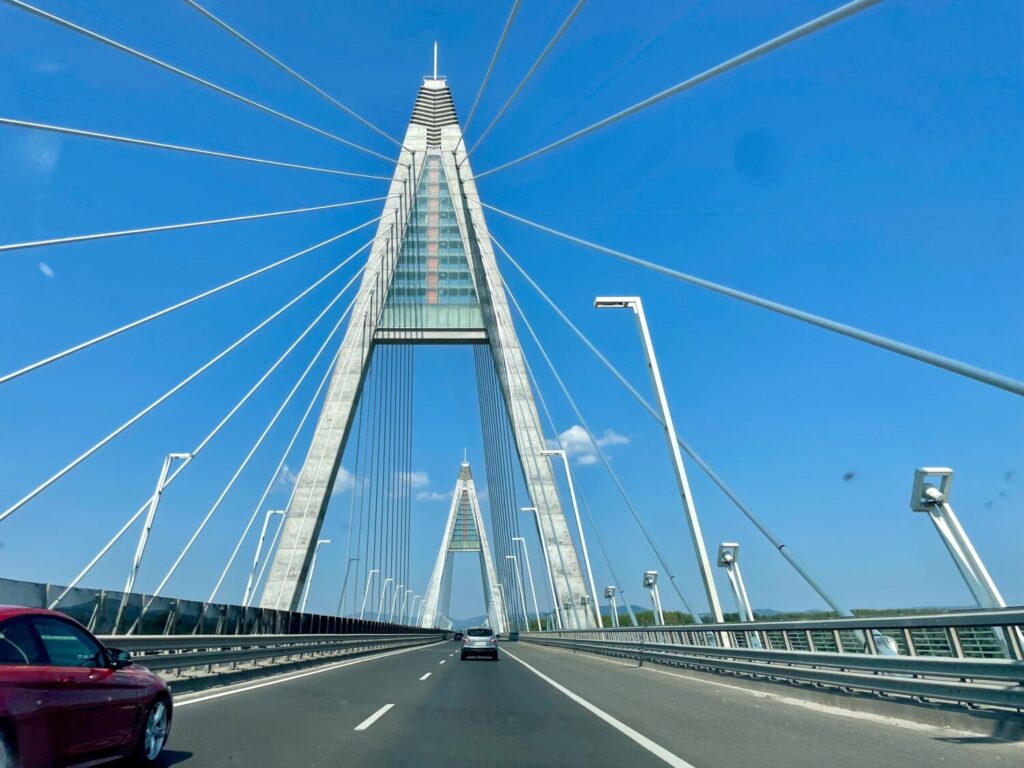
Kalocsa: The Historic Heart of Hungarian Paprika
Kalocsa is the symbolic city of Hungarian paprika, with traditional markets, museums, historic factories and picturesque views of the Danube.
However, what we expected to be a city felt more like a countryside town, with many factories now closed and abandoned. Even the tourist information we had found online on the official website was outdated and incorrect!
Despite this, it turned out to be a wonderful experience for us, as it allowed us to discover a side of Hungary that felt more authentic and less touristy than the capital area we were used to seeing.
Top Sights in Kalocsa: Museums, Miklós Schöffer Tower, and Paprika Factories
When visiting Kalocsa, flexibility is essential because it is difficult to find reliable and up-to-date information online. Plus, what looked very much like the tourist information office, marked with a large “i” sign, turned out to be the ticket office for a temporary exhibition.
The town is so small that you can easily find the main attractions on your own, but keep in mind that shops and museums usually close around 4 pm. The old railway station, decorated with the traditional Kalocsa motifs, is closed. However, if the guardian is there, you can ask to step inside.
You will, however, find open the Viski Károly Museum, a very old-fashioned collection of local objects not particularly engaging for children, and the Archbishop’s Museum, which we did not visit.
The Paprika Museum, on the other hand, is absolutely worth it. Just be sure to go to the Paprikamúzeum in Szent István út 2, and not to the Paprika House (Paprikaház) in Kubinszky út 8, which is closed. Kalocsa also has a small ethnographic museum, Népművészeti Tájház, although it is not open every day.
Kalocsa is above all famous for its paprika. You can view the factory from the outside or purchase spices in the company shop located nearby. The old ceramics factory, however, is permanently closed, and the information still listed on the tourist office website is not accurate.
Nearby, you can see the impressive Miklós Schöffer Tower, a large sculpture created by a local artist with mirrors that move in response to the traffic. We also loved the many blue lever fountains scattered around Kalocsa (and in other Hungarian towns), which gave us the chance to cool down and refill our bottles during the summer heat.
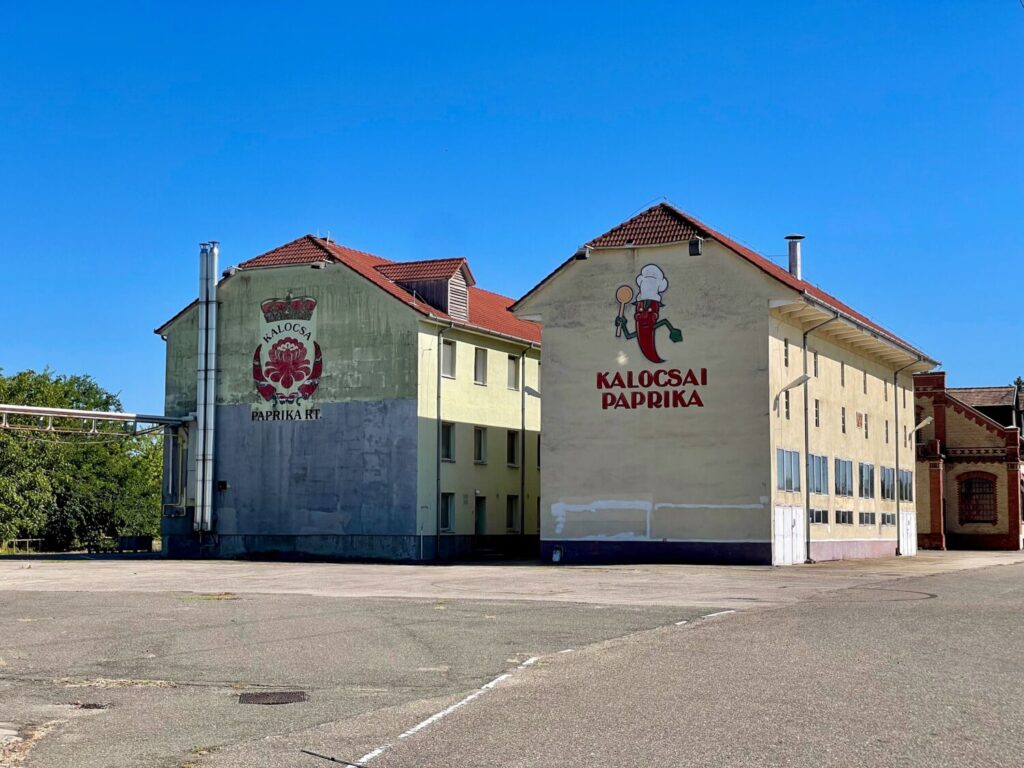
The Kalocsa Paprika Museum: History, Culture, and Spice Traditions
The Kalocsa Paprika Museum is a must-visit if you want to discover the history and tradition of this spice that has become a symbol of Hungary.
Inside, the exhibition has three sections. It begins with the history of Kalocsa, then proceeds to the cultivation and varieties of paprika, and finally concludes with Hungarian wine. I found it very interesting and also suitable for children.
My son had great fun learning about the different types of peppers and their levels of spiciness in the paprika section. I particularly enjoyed the part dedicated to artistic traditions, especially embroidery.
Outdoor Fun Around Kalocsa: Swimming in the Danube
After visiting the centre of Kalocsa, we spent an afternoon swimming in the Danube, which is surprisingly calm here. A short drive away, there is a small beach, easy to reach by car.
We discovered it thanks to Google Maps by searching for “strand”, the Hungarian word for beach. It is frequented only by locals, mostly families and people practising SUP and rowing. For us, it was a fantastic experience surrounded by nature.
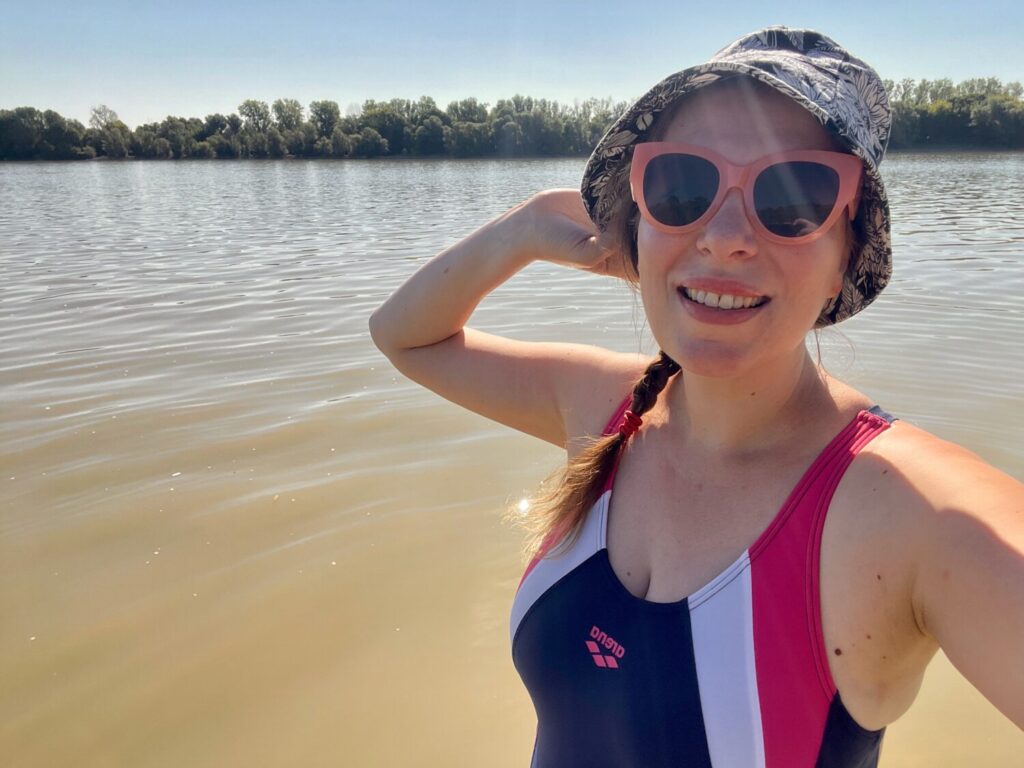
How to Get to Kalocsa and Where to Stay
Reaching Kalocsa by car was simple with Google Maps. Still, the real beauty was the freedom to explore the countryside and lesser-known surroundings. That is how we ended up finding a Danube beach for a swim, discovering authentic spots far from mass tourism.
Parking in the centre of Kalocsa is free, but regulated with a parking disc. You can stay only two hours between 8 am and 4 pm, so you need to update the disc as locals suggested, or find a spot a little further away.
As for accommodation, options are limited, and we wanted something authentic and locally run. We stayed at Piros Arany Panzió, a small family-run guesthouse in the heart of Kalocsa with good reviews. However, this choice turned out to be rather unusual, as workers lived there permanently, and some rooms were used as offices and even as a beauty salon.
Piros Arany Panzió
6300 Kalocsa, Szent István útca 37
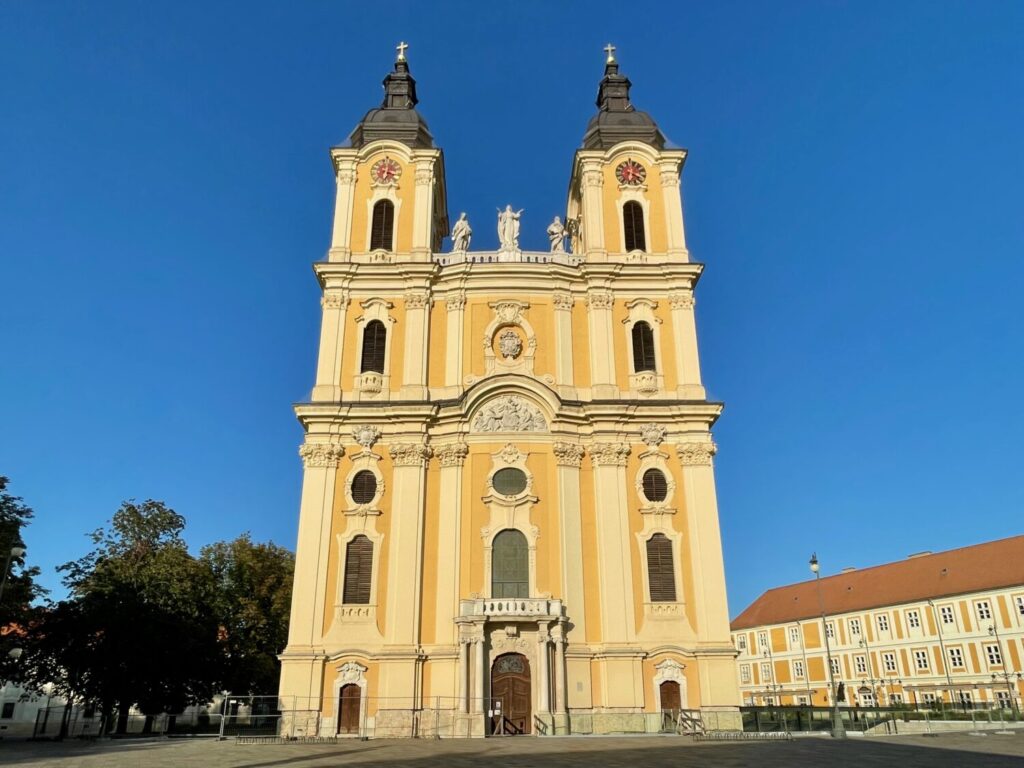
Szolnok: RepTár Aviation Museum for Kids and Enthusiasts
We made Szolnok a stop along the way only to visit the RepTár. This aviation museum is an extraordinary place, designed for families and aviation enthusiasts, with hangars filled with historic aircraft and modern displays.
The museum is spacious and well organised, with captions mostly translated into English, making the visit very accessible. Inside the hangar, you can see numerous planes, including an electric aircraft. On the upper floor, you can see many aviation-related exhibitions. During our visit, alongside the permanent display on the history of Hungarian military aviation, there were two fascinating temporary exhibitions about Japan, focusing on Hiroshima and the kamikaze.
Outside, you will find decorated helicopters, a series of MiGs, a missile defence system, and even a train carriage, a relic of the old railway station that now hosts the museum. For children, there is a military-style training trail and a playground, which I recommend visiting early in the morning during summer, as it gets very hot.
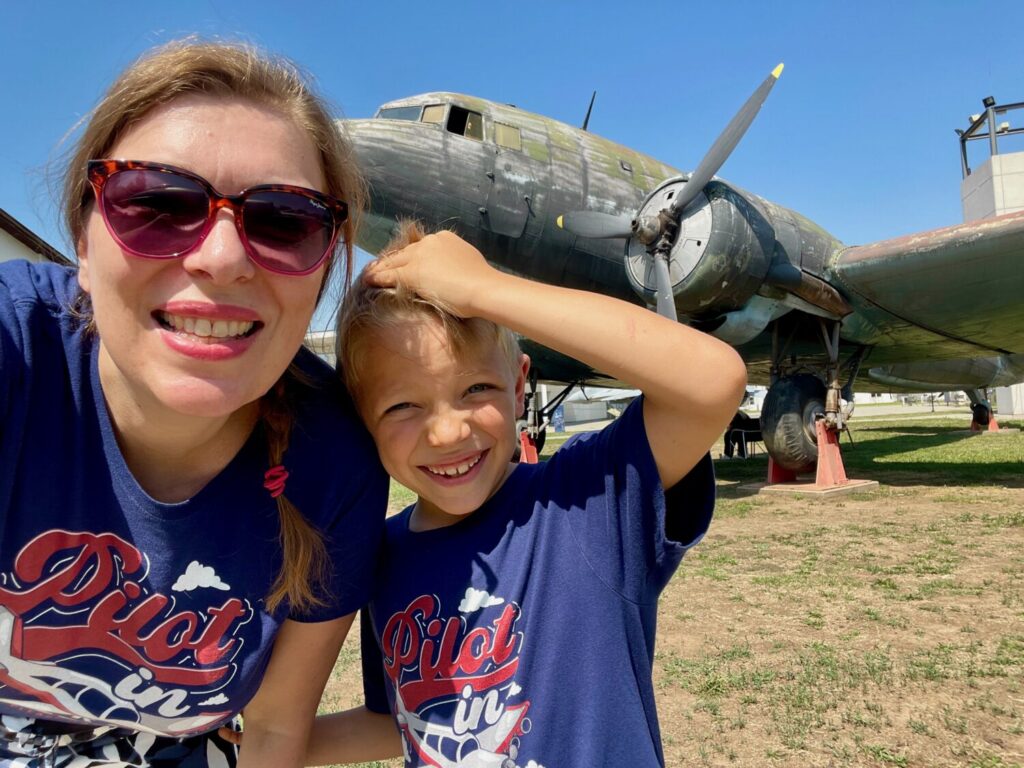
Mezőkövesd: Matyó Culture, Folk Art, and Thermal Wellness
The town of Mezőkövesd is famous for the Matyó community and its UNESCO World Heritage crafts, and for the Zsóry Thermal Baths, perfect for a family day out between the water park and thermal pools.
We started our visit at the tourist office to get an introduction to the local attractions. It’s located in the Hadas district, surrounded by traditional houses, and inside, there is an interactive exhibition about the district and Matyó costumes.
Within walking distance, you can find traditional houses hosting artisan workshops. Among these, the house of Bori Kisjankó, the most famous Matyó designer, will take you back in time.
The district also hosts the Hajdu Ráfis János Agricultural Machinery Museum, one of my son’s favourites on this trip. Inside, you can walk among hundreds of tractors and farming machines, and even see real steam tractors. For children, it is incredibly fun as they can explore driving a small plastic tractor!
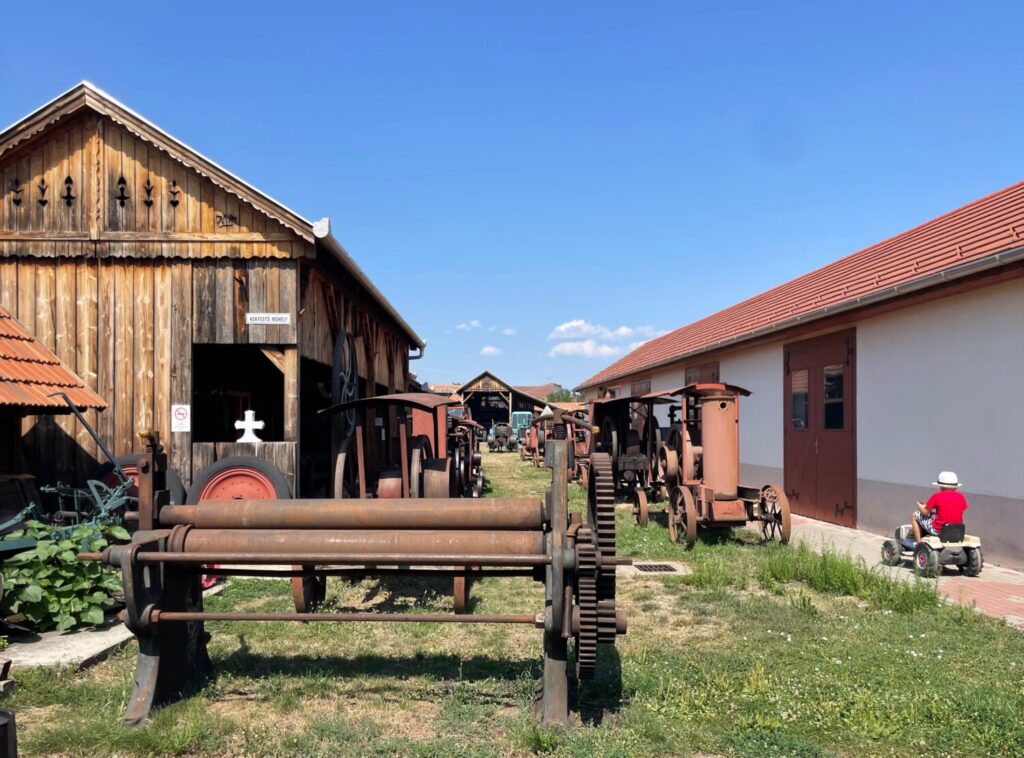
Matyó Museum: Explore Hungarian Traditions, Costumes, and Embroidery
Visiting the Matyó Museum was one of the main reasons for my road trip in Hungary. Even before falling in love with the country, I had already become fascinated by Matyó embroidery, which I consider among the most beautiful in the world.
Compared to the beautiful embroidery common in the Kalocsa area, Matyó designs stand out for their dense, closely spaced patterns, with no empty spaces. The embroidery style evolved over time, and at the museum you can see how it progressed from geometric white-on-white designs to the vibrant multicoloured patterns we know today.
Discovering that Mezőkövesd had a museum entirely dedicated to this tradition shaped the entire itinerary of my trip.
Inside the museum, there is so much to see and learn. The rooms narrate the daily life of Matyó families, which was far more complex than just embroidery. For example, weddings were lavish ceremonies, but they masked a hard life for the bride, who had to move into her husband’s family and work tirelessly.

Zsóry Thermal Bath in Mezőkövesd: Wellness, Relaxation, and Healing Waters
The Zsóry Thermal Bath in Mezőkövesd is the perfect place to spend an entire day enjoying relaxation and fun. The complex is huge and has almost no tourists. Hungarian families come with sun tents and picnic supplies to enjoy the whole day outdoors.
The slides in the water park are accessible with a minimum height of 120 cm. However, I can assure you that younger kids will not get bored, with wave pools and both indoor and outdoor pools available.
In addition to the fun area, there are pools with healing thermal water and a wellness area with saunas, reserved for adults.
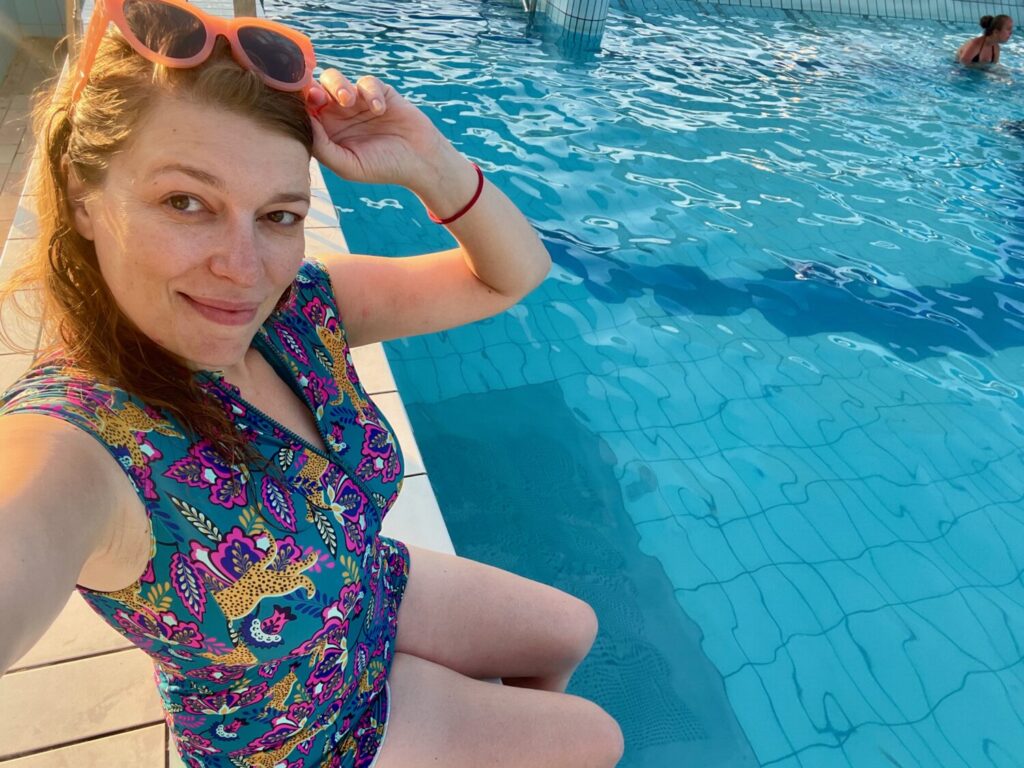
How to Get to Mezőkövesd and Where to Stay
To reach Mezőkövesd from Kalocsa, expect about 240 km, around a 4-hour drive. Along the way, we stopped in Szolnok to visit the RepTár Aviation Museum, which I highly recommend.
In Mezőkövesd, we stayed at Galéria Vendégház, a large private house with private parking converted into a cosy guesthouse. The rooms are spacious and there is a large garden with a table and barbecue. I found it an ideal choice for a family trip, thanks to the outdoor spaces for relaxing and playing. It is also located right in the town centre.
Galéria Vendégház
3400 Mezőkövesd, Alkotmány út 15
Szentendre: Charming Pedestrian Town and Skanzen Open-Air Ethnographic Village
Szentendre is one of those towns that looks straight out of a postcard: cobbled streets, pastel-coloured houses, and a lively atmosphere that blends art and tradition. Entirely pedestrian, the historic centre has museums, galleries and small shops that invite a stroll.
Personally, I found it a bit too touristy. Still, it remains a pleasant and scenic stop, ideal for wandering through squares and cafés.
From Budapest, you can easily reach it by train without needing a car and visit it in a day. We, however, stopped in Szentendre primarily to visit the spectacular Skanzen open-air ethnographic village.
Skanzen Village: Discover Hungarian History, Culture, and Traditions
The Skanzen ethnographic village is undoubtedly the most interesting attraction near Szentendre. Here, you can take a real journey back in time and through the regions of Hungary, thanks to the reconstruction of traditional houses and buildings.
To move around the park, you can hop on a historic train connecting the different areas. Keep in mind that Skanzen is so vast that a whole day is not enough to see everything.
Inside the village, you can freely enter almost all of the houses. Many have explanations recorded in Hungarian or staff acting as guides. Still, you can also rely on the English captions to understand whether the buildings were private homes, workshops or shops. Some exhibitions explain peasant life and the influences of different immigrant communities in Hungary.
A fascinating section reconstructs the border with Romania, as Transylvania was once Hungarian territory. I used this opportunity to explain borders to my son, and it was fascinating to see how a child born in the European Union takes free movement of people for granted, associating showing documents only with airport check-ins.
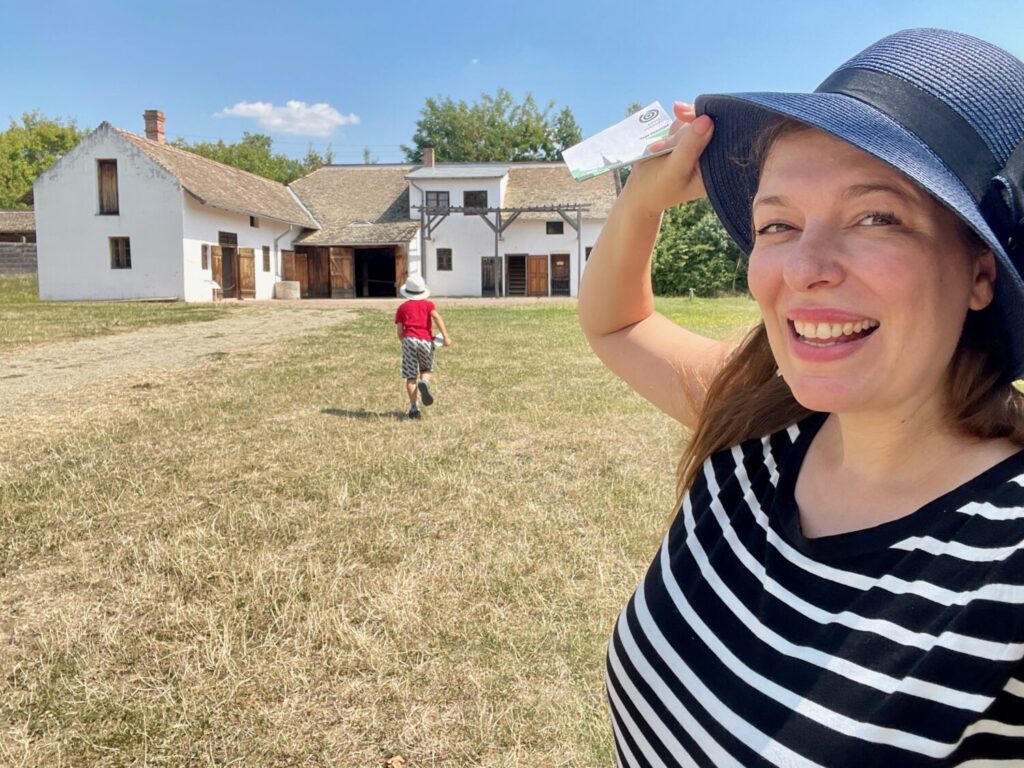
How to Get to Szentendre and Where to Stay
To reach Szentendre from Mezőkövesd by car, expect around 140 km, about an hour and a half. The only congested stretch we encountered was the part crossing Budapest. If you look at a map, Mezőkövesd lies south of the Hungarian capital, and Szentendre to the north.
I expected a bypass or a dedicated motorway to avoid Budapest, but Google Maps took us straight through the city. Driving over the same bridge I had crossed many times by bus and recognising Margaret Island beneath me was a thrilling experience.
The historic centre of Szentendre is entirely pedestrian, surrounded by restricted traffic zones, so pay attention to where you park.
We stayed right in the centre at Városi Vendégház, a guesthouse run by the tourist office. For this reason, you need to check in and pay the city tax at the tourist office. I mention this because it is not clear on Booking. However, the advantage is that the office can also provide a special permit for parking in the area.
Városi Vendégház
2000 Szentendre, 12 Fő té
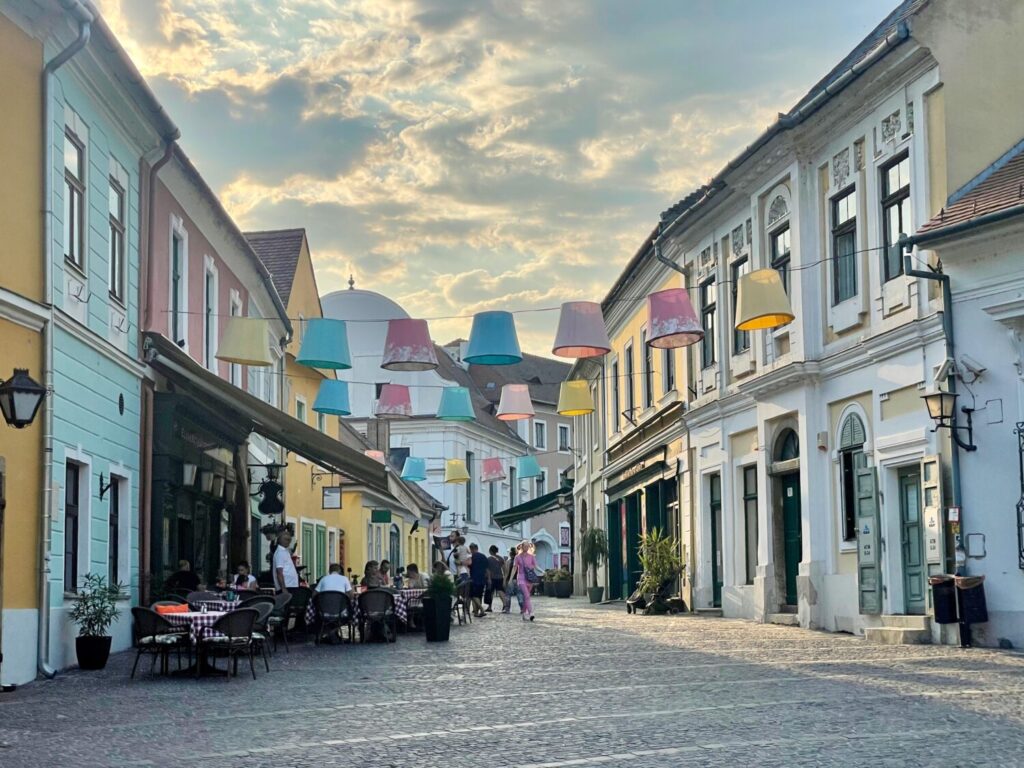
Oroszlány: Mining History and the Unique Floating Village of Bokodi
Compared to the very touristy Szentendre, Oroszlány surprised us with the complete lack of information: no tourist office and hotel leaflets that were at least ten years old.
The main reasons to visit Oroszlány are the Mining Museum and the floating village of Bokodi, two unusual and curious experiences to enjoy with your family.
From here to Lake Balaton, once you are identified as a tourist, people automatically speak to you in German, regardless of whether you understand Hungarian better. English is less common, but you can manage with Google Translate.
Oroszlány Mining Museum: Historical and Industrial Curiosities for Families
The Mining Museum is located just outside Oroszlány, in the old mining area, and having a car is essential to reach it. My son and I really enjoyed it because we discovered many aspects of mining, from the machinery used to the life of the worker community.
Inside the museum, almost everything is hands-on: helmets, tools, uniforms, even the band’s hat and vest. Outside, the large industrial machines are accessible, forming an enormous interactive park, and there is also a small underground gallery that you can explore independently.
My son particularly enjoyed the mine-themed playground and the ride on the little train within the park. Sitting on the wagons that once transported stones and minerals is not at all comfortable, but it is a lot of fun.
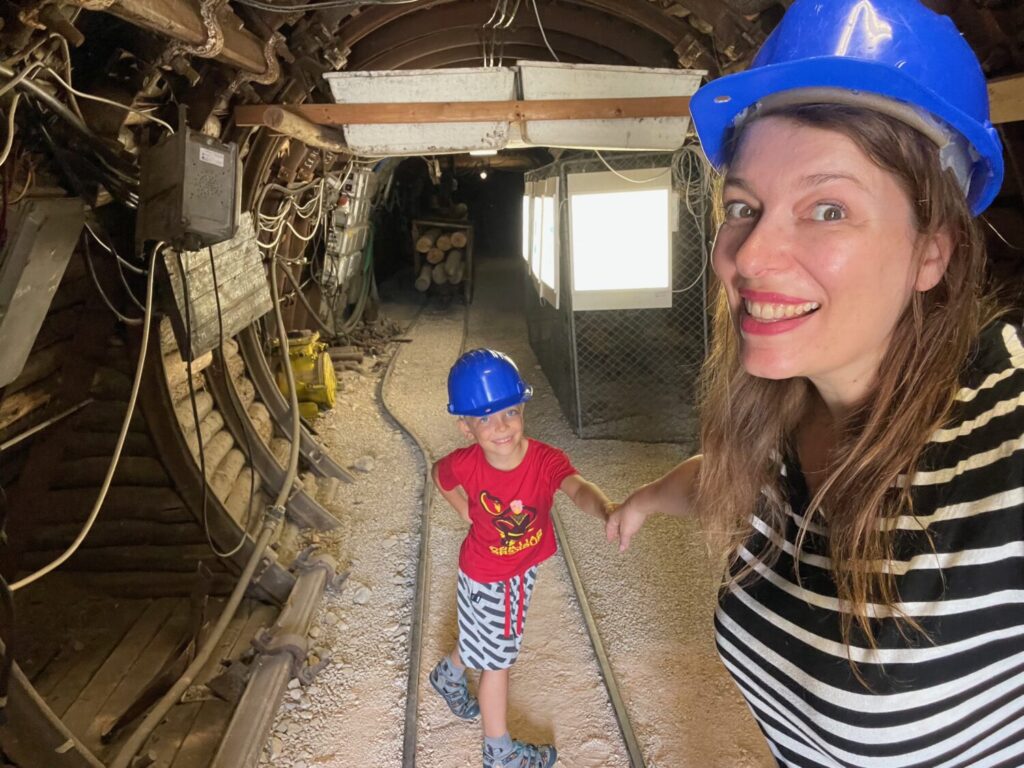
Bokodi Floating Village: A Unique Hungarian Experience
The Bokodi floating village is one of the most photographed attractions in the area and the only floating village in Hungary. The wooden houses on stilts are truly picturesque. Unfortunately, they are all private property, and it is not possible to access the walkways freely.
Bokodi Lake was once known for year-round fishing. The water did not freeze thanks to the continuous circulation from the Vertesi coal-fired power plant located on the lakeshore. Today, this is no longer the case, as the power plant ceased all activity in 2015.
The floating village is still inhabited, but probably due to tourist and visitor traffic, the paths are blocked by gates with clear no-entry signs, “tilos” in Hungarian.
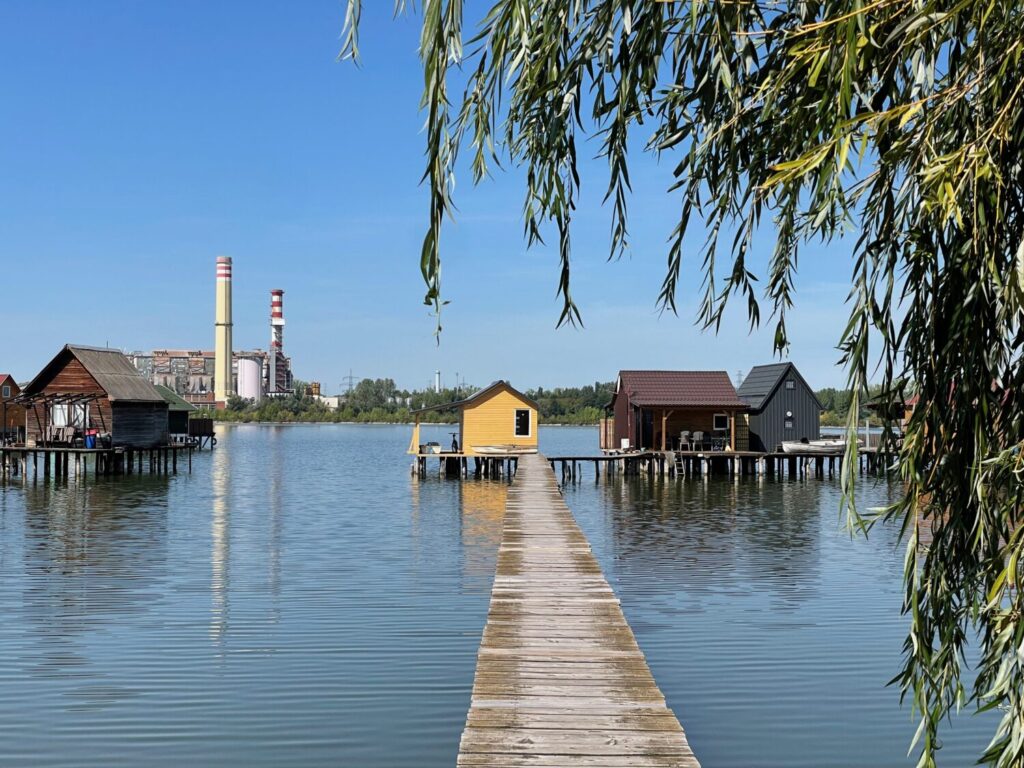
How to Get to Oroszlány and Where to Stay
From Szentendre to Oroszlány, the distance is approximately 97 km, which is roughly an hour and a half by car. A good option for accommodation is Czermann Panzió és Étterem. Although, despite the name, there is no restaurant (étterem in Hungarian).
The rooms are simple and cosy, but what we appreciated most was the large fenced garden, the porch with table football, and outdoor tables for dining. It is a relaxing setting, perfect for travelling families.
Czermann Panzió és Étterem
2840 Oroszlány, Alkotmány út 10
Lake Balaton and Surroundings: Nature, Relaxation, and Water Adventures around the Hungarian Sea
Lake Balaton, known as the “Hungarian Sea,” is the heart of holidays in Hungary and perfect for families and water sports enthusiasts. We spent the last days of our trip at a campsite on the shores of Balaton to fully enjoy its wonderful atmosphere.
Staying by the lake does not mean staying put. With a car, you can explore the natural and cultural attractions in the surroundings, as well as numerous wineries on the hills. Many have restaurants surrounded by vineyards where you can taste excellent Hungarian wine with a fantastic view of Lake Balaton.
Lake Balaton Activities: Swimming, SUP, Kayak, and Water Sports
At Balaton, you can enjoy many water activities: swimming, stand-up paddling, kayaking and rowing. The beaches are very muddy, so you cannot really sunbathe or play on the shore. Still, the calm and shallow waters allow for easy and safe paddling, even with young children.
A popular way to explore the lake’s shores is stand-up paddling. We did not try it because I wanted my son to first take a lesson with an instructor before venturing into open water, but it looks like great fun.

Tapolca Lake Cave: Underground Adventures for Families
Tapolca is renowned throughout Hungary for its cave, which feature a small navigable lake. To visit, I recommend booking online on the official Balaton Nature Park website a few days in advance. Tickets at the entrance sell out quickly, and you might not be able to access them otherwise.
The cave is located right in the town centre, and you can enter according to the time stamped on your ticket. Before entering, you pass through a documentation centre offering introductory information for adults and children.
The real adventure begins at the edge of the underground lake: you row yourself between low rocks and crystal-clear waters in a small three-person boat. Our souvenir photo clearly shows my lack of rowing skills, but we managed to complete the tour safely. The experience is suitable for all ages and very enjoyable for young children.
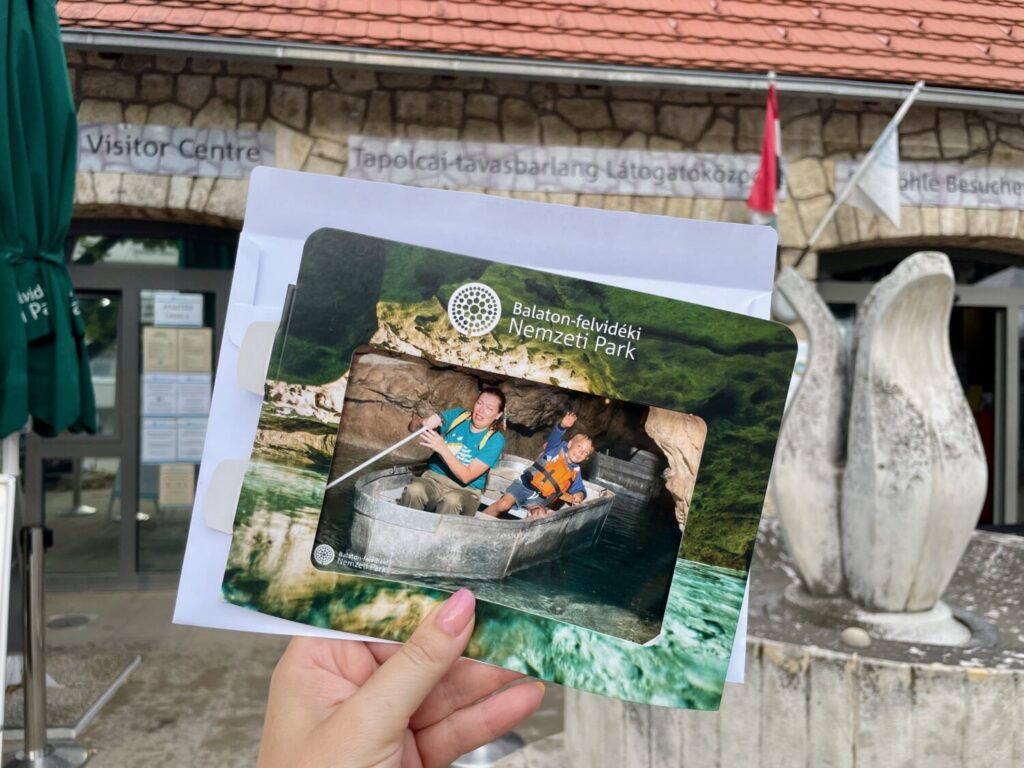
Hévíz Thermal Lake: Natural Spa and Family-Friendly Relaxation
Hévíz Thermal Lake is the largest in Europe, offering a unique experience that combines natural beauty with relaxation. The warm water is dark yet transparent at the same time, creating a curious effect, as if you were swimming on black glass. Surrounding the lake is a beautiful park, and within the facility, you can also get medical treatments or wellness services.
Most visitors spend their time floating in the thermal lake on tubes you can rent at the entrance. For young children, there is a separate shallow pool area, perfect for safe play.

Tihany: Benedictine Abbey and Lavender Fields
The Tihany Peninsula is primarily known for the Benedictine Abbey atop the hill and the lavender fields, which in early summer colour the landscape and fill the air with fragrance. There is a lot to see in Tihany.
With my son, we visited the Abbey’s museum and the Lavender House. The Abbey’s museum tells the story of its foundation and the life around Lake Balaton. In the lavender workshop, instead, you will see foods, oils and perfumes made with this flower.
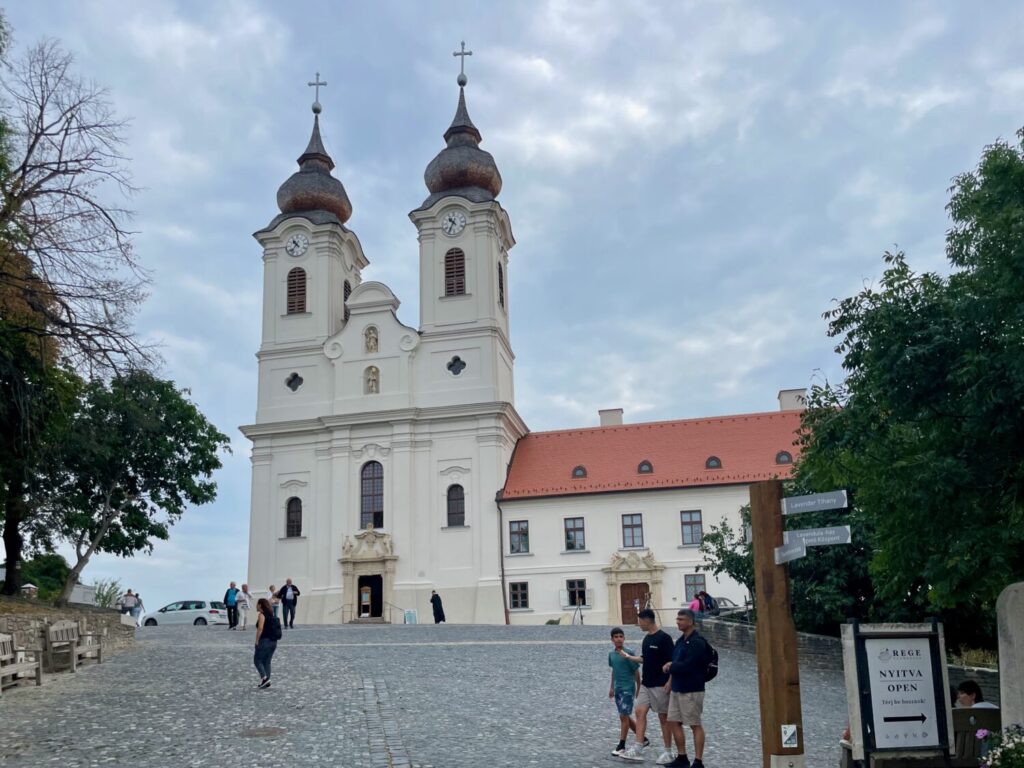
How to Get to Lake Balaton and Where to Stay
From Oroszlány to Lake Balaton, the distance is approximately 145 km, which is around a two-hour drive by car. We spent the last days of our trip at Balaton Eldorado Camping in Badacsonytördemic.
This campsite was a great choice because it is simple and family-friendly, with a children’s pool, private piers for launching a dinghy or SUP, and an on-site restaurant. We rented a room in one of the small cottages, but there are also plenty of areas available for tents and campervans.
The only downside is that Badacsonytördemic does not have the cycling path that runs along most of Balaton’s shore. In the evening, you cannot go for a walk or run outside the campsite because there is only a main road. The village, located on the other side of the railway, has only private houses and is poorly lit.
Balaton Eldorado Camping
8263 Badacsonytördemic, Vízpart 2
Practical Tips for Planning a Memorable Road Trip in Hungary
Travelling by car in Hungary gives you great freedom. Still, it also requires some careful planning around the opening days of various attractions. For example, both the KOMO-SKY 51-es BÁZIS airbase and the Oroszlány Mining Museum are closed on Mondays. Since they are on opposite sides of Budapest, it was not practical to visit both on a Sunday because of traffic, and I had to skip the first one.
Some of the places I visited are not even mentioned in the most popular travel guides. At the same time, other online information proved outdated or unreliable. In some spots, you will need to go in person to check if they are open or closed, such as the Kalocsa ceramics factory.
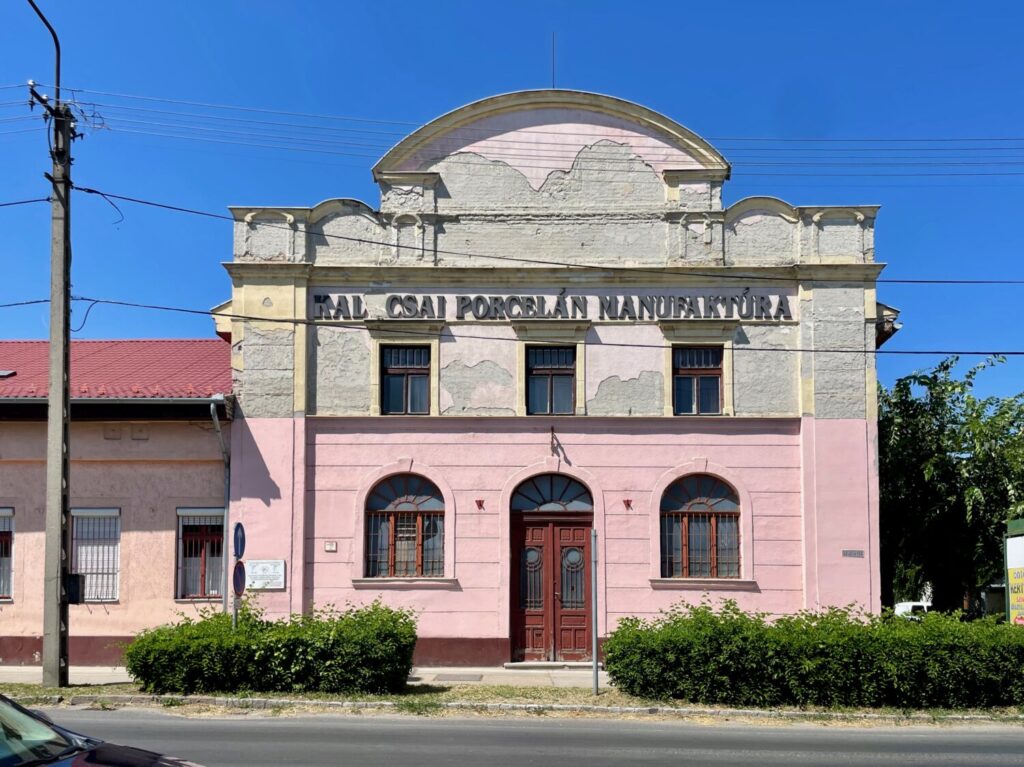
To explore areas off the beaten track, knowing at least a little Hungarian proved essential. English is less widespread than I expected. Especially in the area north of Lake Balaton, people mainly spoke German as a second language, as the lake has been a popular summer destination for tourists from Germany since the days of the DDR.
If you have already travelled in Hungary outside Budapest, share in the comments the places you discovered and what you would recommend not to miss nearby: your tips will be valuable for other travellers!
